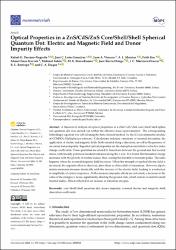Optical Properties in a ZnS/CdS/ZnS Core/Shell/Shell Spherical Quantum Dot: Electric and Magnetic Field and Donor Impurity Effects

Göster/
Erişim
info:eu-repo/semantics/openAccessTarih
2023Yazar
Sahin, MehmetToscano-Negrette, Rafael G.
Leon-Gonzalez, Jose C.
Vinasco, Juan A.
Morales, A. L.
Koc, Fatih
Kavruk, Ahmet Emre
Mora-Ramos, M. E
Sierra-Ortega, Jose
Martinez-Orozco, J. C.
Restrepo, R. L
Duque, C. A.
Üst veri
Tüm öğe kaydını gösterÖzet
A theoretical analysis of optical properties in a ZnS/CdS/ZnS core/shell/shell spherical quantum dot was carried out within the effective mass approximation. The corresponding Schrödinger equation was solved using the finite element method via the 2D axis-symmetric module of COMSOL-Multiphysics software. Calculations included variations of internal dot radius, the application of electric and magnetic fields (both oriented along z-direction), as well as the presence of on-center donor impurity. Reported optical properties are the absorption and relative refractive index change coefficients. These quantities are related to transitions between the ground and first excited states, with linearly polarized incident radiation along the z-axis. It is found that transition energy decreases with the growth of internal radius, thus causing the red-shift of resonant peaks. The same happens when the external magnetic field increases. When the strength of applied electric field is increased, the opposite effect is observed, since there is a blue-shift of resonances. However, dipole matrix moments decrease drastically with the increase of the electric field, leading to a reduction in amplitude of optical responses. At the moment impurity effects are activated, a decrease in the value of the energies is noted, significantly affecting the ground state, which is more evident for small internal radius. This is reflected in an increase in transition energies.

















